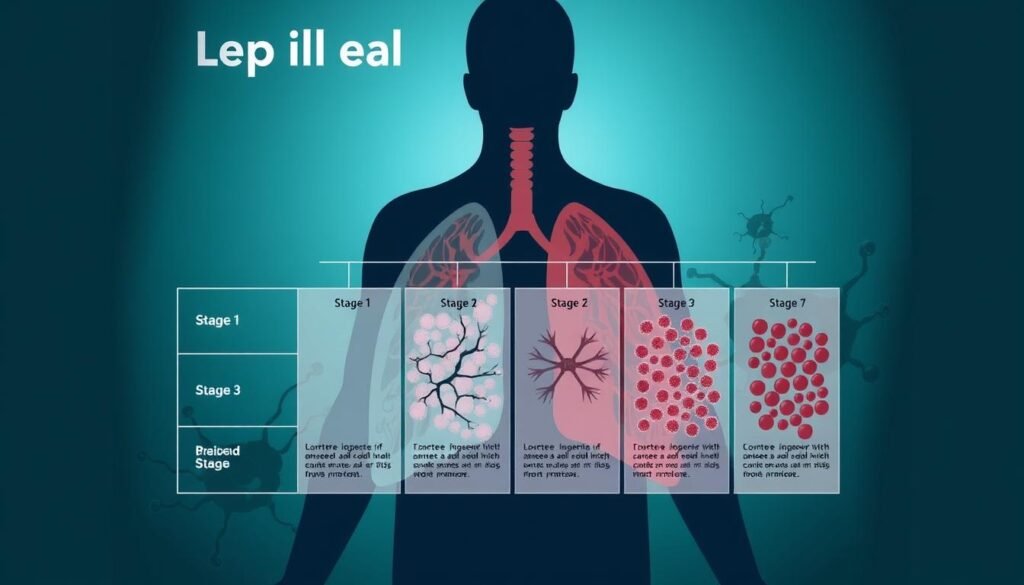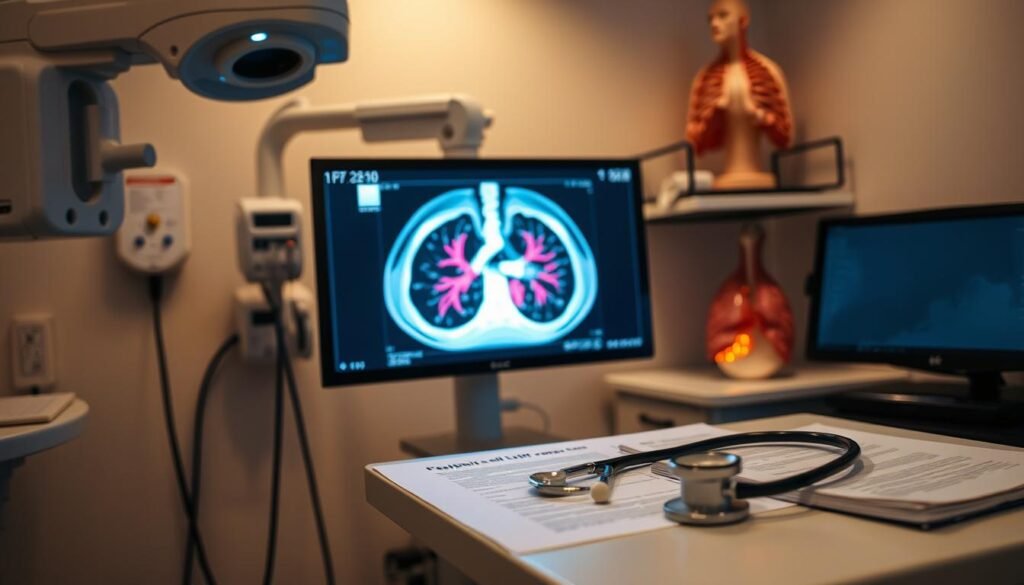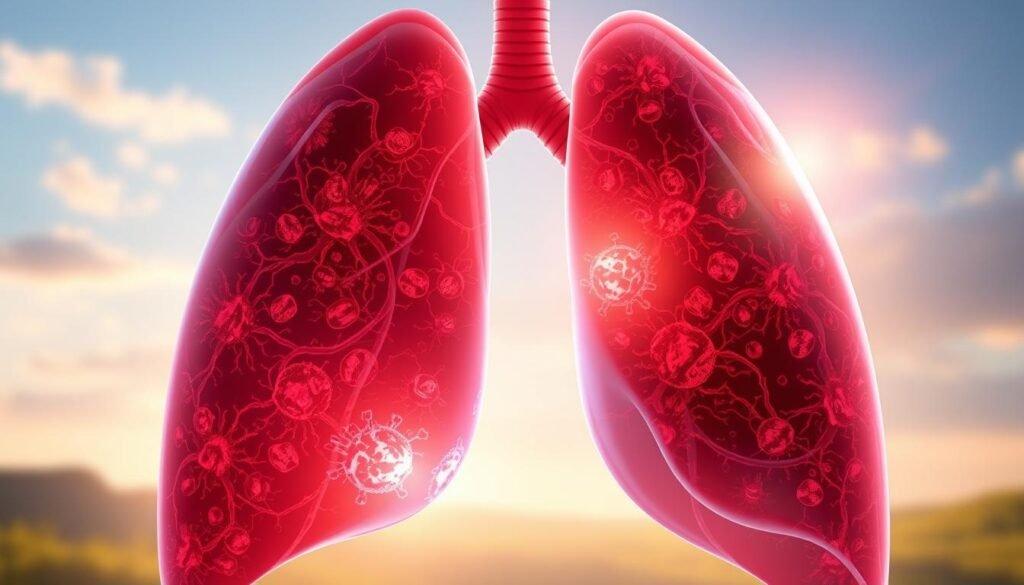Did you know small cell lung cancer (SCLC) makes up about 13% of all lung cancers in the U.S. each year? There were about 230,000 new cases and 130,000 deaths from it in 2022. It’s key to understand SCLC, especially since limited-stage SCLC is only a third of these cases. This highlights the need for quick diagnosis and treatment. Tobacco exposure is the main cause of SCLC, being responsible for 98% of cases.
Knowing the signs of small cell lung cancer and how it’s staged is very important. It can greatly affect how the disease is treated and the outlook for the patient. Patients with limited-stage SCLC often have more treatment options. This can lead to better chances of survival. Yet, it’s vital to remember this disease can come back and is very aggressive.
This guide provides essential facts and details about limited-stage small cell lung cancer. We’ll cover how it differs from extensive stage, signs, diagnosis, treatments, and what to expect. With this information, patients and families can face this tough disease better. They can talk openly with doctors to choose the best care plan.
Key Takeaways
- Limited-stage SCLC constitutes about one-third of all SCLC cases.
- Timely staging is crucial for determining the best treatment options.
- Understanding small cell lung cancer symptoms can lead to earlier detection.
- Approximately 50% of SCLC patients may experience tumor spread to the brain.
- The survival rate for early-stage SCLC after successful surgery can reach around 50% after five years.
- Caution is advised regarding alternative treatments; always consult healthcare providers.
- For a deeper understanding of SCLC and available treatment options, explore diagnosis and testing methods.
Understanding Small Cell Lung Cancer
Small cell lung cancer (SCLC) is about 15% of all lung cancer cases. It’s more aggressive than non-small cell lung cancer (NSCLC). NSCLC makes up around 80-85% of lung cancer cases. SCLC grows fast and often spreads to other body parts early on.
SCLC usually starts in the chest’s bronchi, forming large tumors. Almost 98% of SCLC cases are linked to smoking. It is more common in people who have smoked, affecting men slightly more than women.
Non-small cell lung cancer has types like adenocarcinoma, squamous cell carcinoma, and large cell carcinoma. Each type has different characteristics and treatments. Adenocarcinoma is the most common subtype. The growth and behaviors of SCLC and NSCLC affect treatment and survival chances differently.
It’s important to understand how lung cancer behaves. This knowledge helps to treat each cancer type in the best way. For more info on lung cancer types, check out this resource.
The outlook for SCLC is often poor, mostly because it’s usually found late. This cancer moves quickly, making fast treatment crucial for better health results.
What is Limited Stage Small Cell Lung Cancer?
Limited stage small cell lung cancer (LS-SCLC) is a type of lung cancer. It’s found mainly in one lung and sometimes nearby lymph nodes. Treatments like radiation therapy work well here because the cancer hasn’t spread much.
Doctors use special criteria to diagnose this cancer stage. About 30% of all small cell lung cancer cases are LS-SCLC. The treatments for these patients often mix chemotherapy and radiation. This mix helps improve survival chances.
One key point about limited SCLC is how well radiation therapy works on it. Treatments usually involve high doses of radiation. Sometimes, surgery can be used if the cancer hasn’t spread beyond one tumor.
Getting diagnosed with limited stage lung cancer can be serious but treatable. With the right treatment, survival rates can reach 30% to 35% after five years. This shows how crucial early and proper treatment is.
For more info on limited stage small cell lung cancer and treatment, you can check this study on SCLC classification.
Symptoms of Small Cell Lung Cancer
Knowing the signs of small cell lung cancer is key to catching it early and treating it right. People often see warning signs like a cough that gets worse over time. Although it might be easy to ignore, this cough is crucial for spotting lung problems early.
People with this condition might also feel chest pain. This can be a slight discomfort or very painful. It often comes with other issues, like hard time breathing. If breathing gets harder, it might mean the cancer is spreading. Small cell lung cancer symptoms like weight loss and feeling worn out are common. They show the body is fighting the illness.
How these signs appear can tell us a lot. For example, signs can be different if the cancer is just starting or has spread. If the cancer hasn’t spread much, symptoms might be more local. If it has spread a lot, the effects can be felt throughout the body, like with metastasis.
Seeing a doctor when these signs show up is vital. Finding the cancer early can really help with the treatment. Knowing these lung cancer signs gives people the chance to get help sooner.
| Symptom | Description |
|---|---|
| Cough | A persistent cough that may worsen over time. |
| Chest Pain | Discomfort in the chest area, potentially linked to breathing issues. |
| Difficulty Breathing | Shortness of breath, indicating potential complications. |
| Weight Loss | Unexplained loss of weight, often a systemic symptom. |
| Fatigue | Constant tiredness that does not improve with rest. |
Staging of Small Cell Lung Cancer
Knowing the stage of small cell lung cancer is crucial. It helps decide on treatments and gives insights into outlooks. The TNM staging system is key in this process, focusing on tumor size and place (T), if cancer has reached lymph nodes (N), and if it has spread to other areas (M).
The AJCC breaks down this cancer into two stages: limited and extensive. In the limited stage, cancer hasn’t spread much. It’s still mainly in one lung and might have reached nearby lymph nodes. Here, combining chemotherapy and radiation can cure about 20-25% of folks.
Extensive stage means the cancer has spread more widely, possibly to other body parts. At this point, chemotherapy is the main treatment. Some may also receive immunotherapy and preventive brain radiation, depending on their situation.
Here’s a quick look at the staging differences:
| Characteristics | Limited Stage (LS) | Extensive Stage (ES) |
|---|---|---|
| Definition | Cancer confined to one lung and/or nearby lymph nodes. | Cancer spread beyond a singular area; may involve other body parts. |
| Treatment Approach | Combination of chemotherapy and radiation. | Main focus on chemotherapy, with possible addition of immunotherapy. |
| Surgical Intervention | Surgery rare; if performed, followed up by chemotherapy. | Surgery not usually an option. |
| Prognosis | About 20-25% can be cured with the right treatment. | Usually, a worse outcome as the disease advances. |
To stage cancer accurately, a detailed medical check-up is needed. Tools like contrast-enhanced CT scans and MRI are often used. This helps patients grasp their condition better and make informed choices about their care.

Limited versus Extensive Stage
Small cell lung cancer has two main stages: limited stage and extensive stage. Knowing the difference between these stages is key for planning treatment.
The limited stage means the cancer is only in one lung and maybe nearby lymph nodes. This usually means there are more treatment options and a better chance of success.
Extensive stage small cell lung cancer has spread further. It may have reached other parts of the chest or even the brain. This makes treatment harder and often means the outlook isn’t as good.
The treatments for these stages differ greatly. In the limited stage, combining chemotherapy with radiation can kill cancer cells and shrink the tumor. However, in the extensive stage, treatment often focuses on easing symptoms, as curing the cancer might not be possible.
| Characteristic | Limited Stage | Extensive Stage |
|---|---|---|
| Cancer Location | One lung, possible lymph node involvement | Spread beyond one lung to chest, possibly other organs |
| Treatment Options | Chemotherapy, radiation therapy, surgery | Palliative care, chemotherapy, potential radiation |
| Prognosis | Generally better survival rates | Lower survival rates due to spread |
Diagnosis and Testing for Limited Stage SCLC
The diagnosis of small cell lung cancer (SCLC) uses special methods for accurate tumor evaluation. When doctors suspect SCLC, they use testing for lung cancer to confirm the disease and its stage. About one in three people with SCLC have limited-stage cancer. This fact shapes the diagnostic plan.
Important imaging tests include chest X-rays, CT scans, and PET scans. They check the lungs and nearby areas. A chest X-ray offers a first look. Then, CT scans provide more detail of the chest. They show tumors and if lymph nodes are involved. PET scans add to these, showing where cancer might have spread.
Biopsies are key for a sure diagnosis of SCLC. In a biopsy, doctors take tissue from the tumor to look for cancer cells under a microscope. This step is vital. It confirms the lung cancer type and helps in staging it.

Assessing lymph nodes is very important in diagnosing small cell lung cancer. If nearby lymph nodes have cancer, this helps decide if the cancer is limited or extensive stage. The AJCC TNM staging system helps measure tumor size, lymph spread, and distant metastasis.
Summary of Diagnostic Methods:
- Chest X-ray: Initial imaging to detect abnormalities
- CT Scan: Detailed cross-sectional images of the chest
- PET Scan: Identifies metabolic activity and potential spread
- Biopsy: Confirms the presence and type of cancer
- Lymph Node Assessment: Evaluates if cancer has spread and helps with staging
A combined approach of imaging tests and biopsy is key for staging correctly. This leads to the best treatment decisions.
Treatment Options for Limited Stage SCLC
Treatment for limited stage SCLC aims to cure, considering the cancer’s aggressive nature. A team effort uses chemotherapy, radiation, and sometimes surgery. Each plan is uniquely made for the patient’s needs to boost recovery chances and cut metastasis risk.
Chemotherapy Combined with Radiation Therapy
Chemotherapy with radiation therapy is key for limited stage SCLC. This combo hits tumor cells in the chest hard, raising success rates. Studies show this method boosts survival rates better than using either treatment alone. Healthy patients often live 16 to 24 months longer.
Surgery as a Treatment Option
In certain cases, surgery is an option for limited stage SCLC, like when there’s a single small lung tumor with no lymph node cancer. Lobectomy, or removing part of the lung, might cure. But, surgery depends on the patient’s health and tumor specifics. Often, the tumor’s size and place make surgery not an option.
Prophylactic Cranial Irradiation
PCI is vital for treating limited stage SCLC. It lowers the chance of cancer reaching the brain after initial treatment responses. Without PCI, almost half of the patients might face brain metastases. So, PCI is crucial in treatment plans.
Small Cell Lung Cancer Prognosis
When looking at the prognosis for small cell lung cancer, we take into account several key factors. These factors are critical in figuring out the likely outcomes for those battling this tough type of cancer. The survival chances can greatly change depending on a few things like the cancer’s stage when found, available treatments, and the patient’s overall health.
Factors Affecting Prognosis
The overall health of a person is a big deal in fighting limited stage small cell lung cancer. Patients in better shape often have better survival chances. How well treatments work, like chest radiotherapy and certain chemo, plays a big role in living longer.
Interestingly, those who stop smoking around the time they’re diagnosed cut their death risk by 45% compared to non-quitters. Even folks who quit smoking before finding out they had cancer see some benefits to living longer. However, the timing of getting chemo or radiation therapy doesn’t really change survival rates much.
Small Cell Lung Cancer Survival Rate
People with limited stage small cell lung cancer usually have a better outlook than those with cancer that has spread far. About 30-40% of cases are found early as limited stage. These patients often live between 15 to 20 months after being diagnosed.
Data from the SEER program for 2012-2018 shows different survival rates based on how far the cancer has spread. For local cancer, the 5-year survival rate is 30%. It drops to 18% for cancer that has spread to nearby areas. And it’s only 3% for cancer that has spread far. Overall, the survival rate for all stages combined is around 7%. This information helps in understanding what to expect and how to plan for treatment.

| Stage | 5-Year Relative Survival Rate |
|---|---|
| Localized | 30% |
| Regional | 18% |
| Distant | 3% |
| All Stages Combined | 7% |
Targeted Therapy for Small Cell Lung Cancer
Recent studies on targeted therapy for small cell lung cancer (SCLC) hold promise for changing treatment. About 15% of lung cancer cases globally are SCLC. Targeted therapies could make treatments better and reduce side effects with a personalized touch.
Tests are looking at drugs that change cell signals or fight drug resistance. Take tarlatamab, for instance. It shrunk tumors in 40% of people who tried it, offering hope for longer survival compared to standard care.
Some drugs didn’t work as hoped, but research goes on. mTOR, IGFR, and Met inhibitors are new areas being explored. They could change how we treat SCLC, making therapies more effective.
Finding better treatments for SCLC is key, showing the shift in cancer care. These efforts aim to raise survival chances and improve life quality with customized treatments. For more on targeted treatments for small cell lung cancer, click here.
| Therapeutic Agent | Target | Trial Results | Median Survival Improvement | Side Effects |
|---|---|---|---|---|
| Imatinib | C-kit receptor tyrosine kinase | No sufficient efficacy | N/A | Minimal |
| Gefitinib | EGFR tyrosine kinase | No improvement in response rates | N/A | Minimal |
| Tarlatamab | Specific target in SCLC | 40% tumor shrinkage | 14.3 months | Cytokine release syndrome |
Conclusion
Understanding limited small cell lung cancer (LS-SCLC) is crucial for better treatment and improving chances of survival. About 40% of SCLC patients are caught early, making quick actions essential. Treatments like chemotherapy, using drugs such as cisplatin and etoposide, play a key role. Additionally, chemoradiotherapy advances have been vital in enhancing survival and life quality.
The outlook for LS-SCLC patients can be tough, with a 5-year survival rate around 25%. But new methods like prophylactic cranial radiation are showing hope. They help lower the risk of brain metastases and boost survival chances. Therefore, talking with healthcare providers about treatments and trials is important.
Awareness about LS-SCLC allows people to manage their condition better. Knowing how crucial early detection, treatment options, and improved prognosis are leads to better health results. Patients can feel more in control and hopeful about their future.